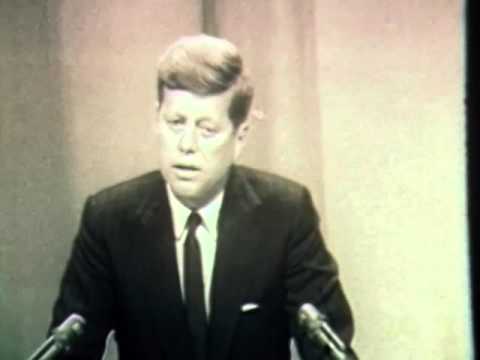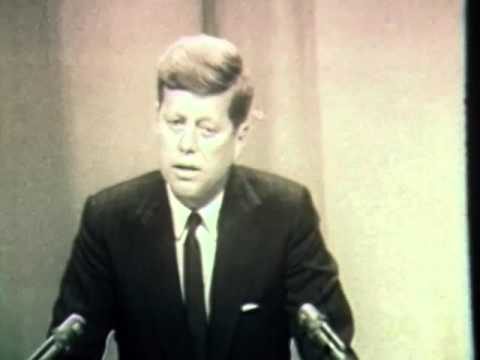

January 25, 1961…Television’s First Live Presidential News Conference
January 25, 1961…Television’s First Live Presidential News Conference
There are three videos with this article; the embedded footage is of President Kennedy hosting the first live news conference, and notice at 10:05, a reporter asks if taking questions live is a good thing given that live there is the occasion to mis-speak and rile international tensions (hint, hint), and the second video shows Kennedy’s amazing grace and humor. The third is part of Eisenhower’s first televised news conference that was shot on film.
On this day in 1961, President Kennedy held the first ever live presidential news conference. It originated from the auditorium of the State Department and was carried live on both radio and television.
In the period preceding the Kennedy presidency, the rules governing press conferences favored the president. The sessions were off-the- record events, from Woodrow Wilson through Harry Truman. If the president said something he believed unwise, he could alter the quote.
President Truman, for example, was able to back away from a comment about Senator McCarthy that he made in a March 30, 1950, press conference. Truman said: “I think the greatest asset that the Kremlin has is Senator McCarthy.” When one of the reporters commented that the president’s observation would “hit page one tomorrow,” Truman realized he had better soften the statement. He “worked” with reporters and allowed the following as a direct quotation: “The greatest asset that the Kremlin has is the partisan attempt in the Senate to sabotage the bipartisan foreign policy of the United States.”
When the rules governing press conferences were off the record, chief executives held them once or twice a week. In fact, Calvin Coolidge, who held the most press conferences for the number of years he was in office, had 521 sessions or an average of 93 a year. But once they went on the record in the Eisenhower administration, the numbers dropped drastically. Now they had to take time preparing for the sessions and then be careful what they said when answering questions. Eisenhower and Kennedy respectively had 24 and 23 press conferences a year.
The first televised (film footage) press conference was held January 19, 1955. President Eisenhower came into the Indian Treaty Room, a room with poor acoustics and limited seating and announced the “experiment” they were about to be part of. https://www.c-span.org/video/?c4480322/president-eisenhowers-first-televised-press-conference
In fact, television made an enormous difference in the significance of press conferences in presidential publicity. It has been a “disturbing influence”—presidents have made mistakes though only rarely—but the sessions also have been an enormous resource for presidents as they seek to explain policy and themselves to the public.
President Kennedy was able to assimilate the new technology into an invigorated presidency, much as he had during the campaign and in the presidential debates. Kennedy’s press conferences were in many ways a symbol of his successful use of television to promote his active agenda.
http://www.youtube.com/watch?v=mXDLLUOxmsY At this link is a video that reminds us of JFK’s easy style in these press conferences. He was the first American president to really understand television and how to use it to his advantage, which started during the campaign.
The image of a fast-paced presidency was not an illusion in the Kennedy years. It was real. Take the pace of their public speeches. President Eisenhower and President Kennedy had a few more than 700 speeches and remarks, big and small, during their presidencies. For President Eisenhower those public remarks covered eight years and for Kennedy, it was less than three years. Many of those speeches got to the public either through their being televised or through news broadcasts.
Because of the high demand by reporters for seats, the conferences had to be moved from the White House compound where they were held first in the president’s office – Wilson through to Truman – and then moved to the larger Indian Treaty Room in the Truman and Eisenhower administrations. Even that room turned out to be a cramped space. Kennedy moved them here in the State Department auditorium where there was more space for the 200+ reporters covering him and his press conferences.
Reporters were more willing to challenge the new president than was true in the Eisenhower years when the goodwill from World War II was still in the air. At the end of the Eisenhower administration, reporters lost their willingness to take at face value the government’s accounting of events.
The U2 spy plane incident changed the relationship for many reporters with their government. It was an incident where the US government was caught in a lie – it was a spy plane the Soviets shot down, not the weather plane the White House said it was. When reporters found out they were lied to, they became wary of the accounts they received from White House officials.
The incoming team of reporters, many of whom followed Senator Kennedy as he campaigned for the presidency, caught the public eye as did the new president. They all prospered from press conferences where each side sought to establish control in its relationship with the other. And so it goes. -Bobby Ellerbee
https://www.youtube.com/watch?v=lFde6u-OPj8
President Kennedy begins the press conference with a statement concerning the scheduling of the Geneva negotiations for a nuclear test ban. He then announces…
You will NEVER AGAIN see such a nice, orderly, MUTUALLY RESPECTFUL Presidential press conference.
Electro-Voice (Buchanan, MI) developed a special “shotgun” mic to pickup the questions from reporters.
I was there. WWDC was selected to provide coverage of this and other events in DC for various groups of radio stations throughout the USA. News Conference was at the State Department.